Searching for spatial information science that would be useful for
everyone in the future,
the Anagura researchers went to meet six researchers.
everyone in the future,
the Anagura researchers went to meet six researchers.
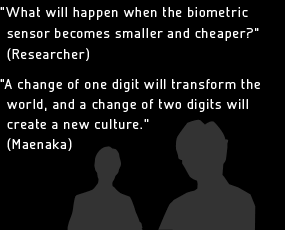
I am developing Ikitoiki [Breathing], a device for monitoring a person's biometric information. When I was studying ways of making the biometric sensor smaller, from a certain source I obtained a sample of an adhesive plaster-type biometric sensor, which carries all kinds of sensors. So I went to see the person who made it.
(At the School of Engineering, University of Hyogo,
on a certain day in the year 2011)
- Researcher
- Researcher: I keep a sample of the adhesive plaster-type biometric sensor that you made on my desk in Anagura. I was amazed that it is so small. Is it a prototype?
- Maenaka
- Actually, I made that one with the intention of making something that was really no good.
- Researcher
- Eh? You mean that one is no good at all?
- Maenaka
- That prototype shows what we would get if we made it with current technology. We are pursuing our research and development within the framework of ERATO [Exploratory Research for Advanced Technology], a five-year project being implemented by the Japan Science and Technology Agency. This is the fourth year. In the last year, we are scheduled to put together our final results. What we are aiming for is a biometric sensor that utilizes original MEMS [Micro Electro Mechanical Systems] technology.
- Researcher
- What is MEMS? Can you explain in more detail?
- Maenaka
- To put it simply, MEMS is a micro system integrating a tiny mechanical structure and a tiny electric circuit. Since it uses the same technology that creates semiconductor chips in computers, minute processing is possible, and it can be produced cheaply and in large quantities. Those are its characteristics. For example, there is a measuring device called a gyroscope, which measures angular velocity [speed of rotation] and maintains balance in vehicles and so on. Highly accurate gyroscopes carried aboard airplanes and spacecraft are extremely large, but using MEMS technology they can be reduced to the size of a small button with just a slight drop in accuracy. If they can be made as small as this, they can be used, for instance, in systems to correct camera shaking, prevent sideslip by cars, and input motion in game machines. Everyday uses will expand. Indeed, although it is a little known fact because they don't stand out, MEMS sensors already play a big part in our lives.
- Researcher
- In other words, our lives are surrounded by MEMS.
- Researcher
- What form will the adhesive plaster-type biometric sensor take in the near future?
- Maenaka
- In the ERATO project, our biggest goal is miniaturization. In the present prototype, individual sensors are arranged loosely. If we use an MEMS module to bring all the sensors together into one, it will be possible to further reduce the size. We are proceeding with that development right now. It is an adhesive-plaster type, so people will be especially concerned about the thickness when they stick it on their bodies, won't they? Therefore, it is important to make the plaster as thin as a membrane. Our target is a thickness of 1窶錀2 mm. The plaster is scheduled to carry a total of 10 sensors: five to measure physical data relating to body temperature, pulsation, blood pressure, perspiration, and physical exercise [triaxial acceleration], and five to measure environmental data relating to air temperature, air pressure, sunlight, humidity, and noise.
- Researcher
- What are the technological issues involved in making the plaster thinner and smaller?
- Maenaka
- The biggest obstacle is the battery. If a battery is carried to enable continuous operation for a certain period of time, inevitably the plaster has to be thicker. What we are considering now is a power generation mechanism called "power harvest." If there is a mechanism for power generation, there is no need for a battery, right? Specifically, one way to realize this might be to use a piezoelectric element. A piezoelectric element is a material that generates voltage when it is skewed. If we can use it both as an acceleration sensor and as a means of generating power as a result of the vibration caused by physical movement, we can kill two birds with one stone. However, it will take time to realize this method. We see this as a medium-term theme, rather than a theme that can be completed in the ERATO project. Also, we are advancing research on a power generation element using an electret, which maintains electric charges, the source of electricity. If the plaster were attached in places where there is plenty of sunlight, solar batteries would be another realistic candidate, but for the time being we are trying to respond with thin-film batteries.
- Researcher
- Are you thinking of any forms other than the adhesive-plaster type?
- Maenaka
- What we are imagining as a variation is an earring type of sensor. I don't know whether they are feasible, but there is also talk of a ring type and an earphone type. These types are being considered because the ears and fingers are ideal for observing blood flow, since they are located a little distance away from the heart. In other words, attaching the adhesive plaster-type sensor to your chest, you can see the time taken from the moment the heart beats to the reaction of the blood vessels in the ear or finger, which tells you the amount required in response to blood pressure.
We are also thinking of a mouthpiece type. In the mouth, it would be easy to acquire information relating to eating and talking. Sensors would be implanted in two or three teeth; they could also be implanted in artificial teeth. From the movement of the teeth, it might be possible to speculate about mental condition, such as whether communication is being made properly and whether there is a tendency toward depression.
- Researcher
- The analysis of biometric data tells a lot, doesn't it? What other things can be understood?
- Maenaka
- There are many things being considered generally. For example, an analysis of frequency components from pulse fluctuations shows the condition of the sympathetic nerves and parasympathetic nerves, in other words, whether the person is feeling stress or relaxing. Or taking biometric data while a person is asleep shows the amount of REM [rapid eye movement] sleep and non-REM sleep, which tells you a good time to wake that person up. However, nobody knows yet exactly what to investigate and what can really be understood, because no one has taken data continuously for a whole year while carrying on a normal life. So it is important to collect data and analyze it. First of all, we are completing the hardware necessary for that purpose. After this project, we hope to think together with everyone in society about what role the acquired data can play.
- Researcher
- For that reason, popularization is important too, isn't it?
- Maenaka
- That's quite right. And for popularization, it is important for the device to be cheap and small. People often say that "It's just got a little cheaper" or "It's just got a little smaller," but if it gets a lot cheaper and smaller, then it will be a different story. I believe that a change of one digit will transform the world, and a change of two digits will create a new culture. Imagine a world in which an adhesive plaster-type is as cheap as disposable contact lens, can be purchased at a convenience store, and can be taken off and thrown away after two or three weeks of use. Just as mobile phones created a culture, so such sensors will create a new culture in all kinds of fields, including health management, peace of mind, and safety.
- Researcher
- I'm already looking forward to that day. What issues do you think are involved in their popularization in society?
- Maenaka
- I wanted to make a biometric sensor because I wanted to look at myself objectively. Human beings, including myself, are fascinating creatures, you know. So once I became a human guinea pig and attached a biometric sensor to myself for 24 hours. What I understood then was that privacy is laid bare for all to see. Others might understand data relating to not only your physical condition, such as the number of times you turned in your sleep, the number of cigarettes you smoked, and the number of times you went to the toilet, but also your mental condition, such as the fact that you might be feeling sudden mental stress because your heartbeat has changed suddenly even though you are not exercising. Therefore, biometric information must be completely private information. Proper management is necessary if it is to be processed or accumulated.
- Researcher
- I see. When I return to Anagura, I will consult with the researcher developing Wakaranu [Anonymity].

Kazusuke Maenaka
Professor, Department of Electrical Engineering and Computer Science, Graduate School of Engineering, University of Hyogo








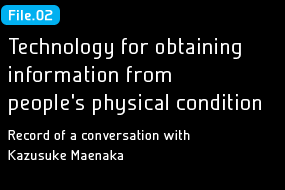


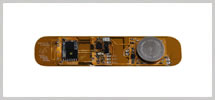



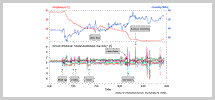
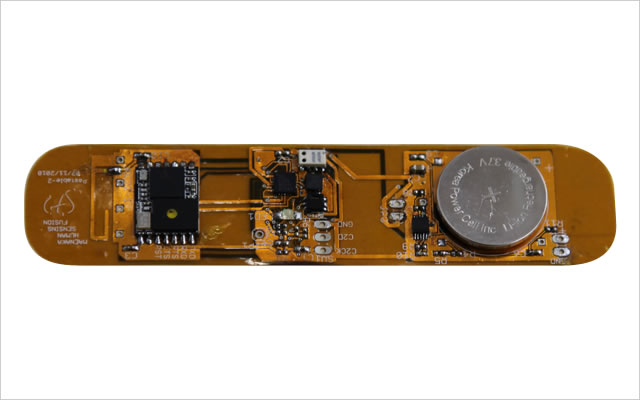 Prototype of the adhesive plaster-type biometric sensor
Prototype of the adhesive plaster-type biometric sensor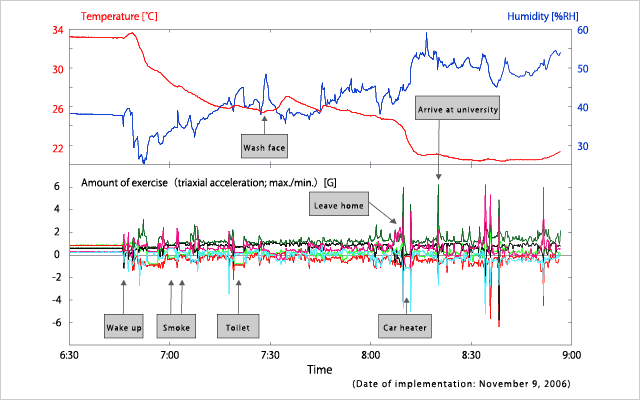 Example of Data Obtained from a Biometric Sensor
Example of Data Obtained from a Biometric Sensor
 Page top
Page top
